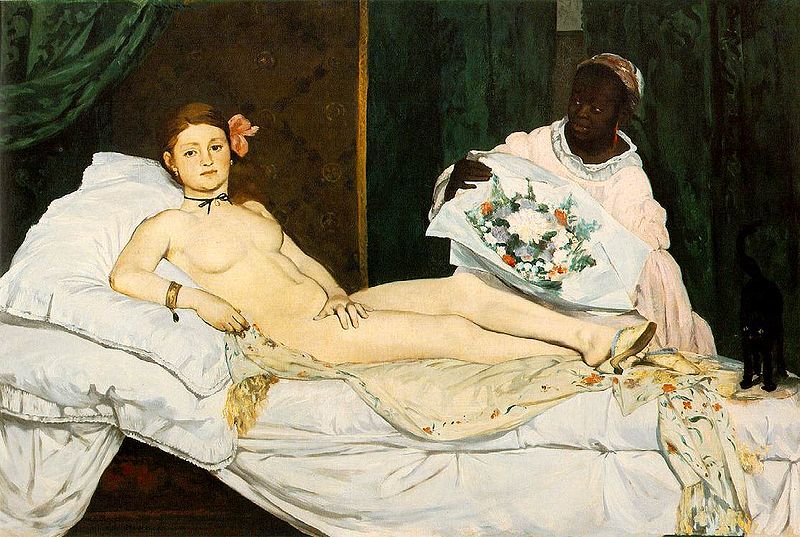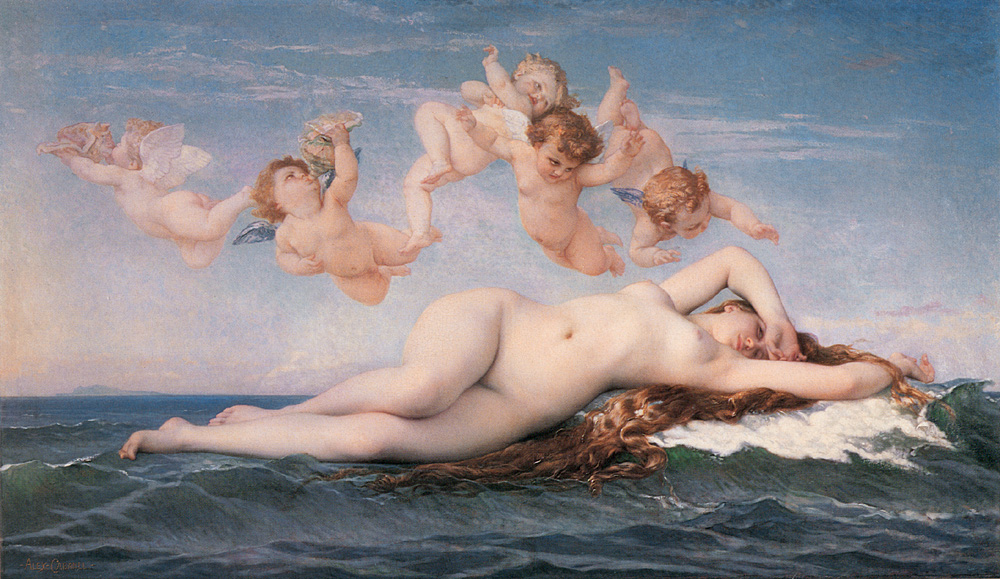There are few styles in art that fell so far into disrepute as the once prized academic art of the nineteenth-century. As awful as much of it was, there are still grounds for some of it to be redeemable and to be recalled from purgatory. …..

"There has been much made about the style of modern art as a response to war but I think one could make the case for Bouguereau and his art as an equally valid response. His art was a refuge from what must have been for him a sad, painful personal life, burying almost all of his children and then his wife at a relatively young age. ..." read more: http://artandinfluence.blogspot.com/2010/10/adolphe-william-bouguereau-1825-1905.html
Two considerations above all else attracted buyers. One was a slick technique, which made of the painter a virtuose without any real narrative in the work; the technical level of Salon painting was quite elevated. The second was anecdotal interest. A painting first of all had to be an illustration and many painters based their success on a single anecdotal gimmick. The situation was one of a painter appealing to a new mass public on other than aesthetic grounds of which they were generally quite ignorant. An ecstatic love affair between the new affluent purchaser with mediocre taste and the technically skilled painter of mediocre conceptions. And the Salon was their trysting place.

Manet Olympia. "...They both feature courtesans gazing at, presumably, a client. “Olympia” contains some critical differences from its predecessor, though. The most obvious is in Olympia’s demeanor. She is not melting under the viewer’s gaze. She is staring them down. Manet was riffing on “Venus of Urbino” to prove a point. He wanted to show how the Venetian tradition and ideas of sexuality propagated for centuries had changed in the modern era. The most interesting difference to me is in the small details. Notice the puppy curled up on the courtesan’s bed in “Venus of Urbino.” Now look for the hunched over cat in “Olympia.” I came up with a theory about how these two animals align with the artist’s intentions. The puppy symbolizes familiarity and loyalty. The viewer can be comfortable looking into the room. The cat, however is in a stance of hostility. It goes along with Olympia’s unwelcoming facial expression...." read more: http://thestarvingarthistorian.wordpress.com/2010/10/31/great-remixes-in-art-history/
Armies of nudes swarmed across the Salon walls , pretty girls without a stitch on but elaborately disguised by titles. A bourgeois society obsessed with the surface observance of a moral code unsympathetic to the display of the body found the most delicious release in artistic subterfuge. The Emperor Napoleon III himself bought Cabanel’s “Birth of Venus” out of the Salon in 1863, yet in 1865 Manet’s “Olympia” was a scandal for its “indecency”.

"Cabanel's Birth of Venus (Musée d'Orsay, Paris) created a sensation at the Salon of 1863, which was known as the "Salon of the Venuses" because several paintings of the goddess were exhibited. This painting embodies the ideals of academic art in its careful modeling, polished surface finish, and mythological subject. Cabanel's picture established his reputation, and it was purchased by Napoleon III for his personal collection. In 1875, the American banker John Wolfe commissioned the present canvas, one of numerous replicas Cabanel made after the original. Source: Alexandre Cabanel: The Birth of Venus (94.24.1) | Heilbrunn Timeline of Art History | The Metropolitan Museum of Art
Cabanel’s Folie-Bergere beauty suggests one thing and one thing alone; even the official critics found her daringly “wanton”. But since she was a Venus conventionally, and very skilfully painted by a ranking academician, everything was all right. The culture more than made up for the wantonness, and the lines of the picture were found to be of “great purity,” which helped. But Manet’s masterpiece was compared to “high” game and the people who gathered around it, to morbid curiosity seekers in a morgue. The latter comparison was not far from wrong, since they had come to see a “dirty” picture, the critics having given this label to “Olympia” because the model was boldly and objectively painted as a Parisian courtesan, unabashed. Honesty was always a dangerous topic in the Salon.
The nude had been a standard test piece for centuries, but since art for art’s sake did not interest the Salon public, and since the nude for the sake of the nude was morally suspect, the Salon painters invented a hundred ways to involve nudes or seminudes in acceptable anecdotal situations. Psychiatrists would have no trouble explaining why these females got into so many painted difficulties . They were always being sold into slavery while prospective buyers subjected them to such indignities as examining their teeth. They were often put to the torture, lashed to stakes and the like, and they languished in prisons on heaps of straw while coarse guards stood by indifferently.

Landseer. Andrew Graham Dixon: The subject of Landseer’s portrait was an itinerant American lion-tamer called Isaac Van Amburgh, popularly known as “Van Amburgh the Brute Tamer”, whose performances at Drury Lane and Astley’s Amphitheatre drew huge London audiences in the early months of 1839. One of Van Amburgh’s keenest admirers was the young Queen Victoria herself, who went to see his show at Drury Lane six times in as many weeks, on one occasion staying behind after the curtain fell to watch the big cats being fed. “One can never see it too often,” she wrote in her journal for 29 January 1839. “Van Amburgh … has great power over the animals, & they seem to love him, though they are in great fear of him. He took them by their paws, throwing them down & making them roar, & he lay upon them after enraging them.” The Queen almost immediately commissioned Landseer, the most fashionable animal painter of the time, to paint a portrait of Van Amburgh performing his death-defying stage act. That painting is still in the Royal Collection today, but the work reproduced here, Landseer’s second and only other version of the subject, was painted a few years later for the Duke of Wellington. Wellington also greatly admired Van Amburgh, and was so delighted with Landseer’s portrait that he paid him £1000 for it, twice what the painter had asked,... read more: http://www.andrewgrahamdixon.com/archive/readArticle/119
They couldn’t so much as disrobe for a quick dip in a woodland pool without being taken by surprise. Naturally, they resented all this, and their expressions of outraged modesty allowed the observers in the Salon to combine perfectly normal sympathy for the poor things with equally normal but less open response to their charms. Every
ure in history who could conceivably be shown undraped or partially undraped was represented time and again. Then there were the nymphs, the bacchantes, and the other lively creatures who by tradition could not only go naked but could be sportive about the whole thing because, like Venus, they had been playing the culture secret since ancient times.

Jehan Georges Vibert. A Fine Point. http://commons.wikimedia.org/wiki/File:Vibert_Jehan-Georges_A_Fine_Point.jpg
Children were almost as popular as nudes, and it was even easier to find things for them to do. Without question, the Salon produced in its simpering, mincing pictures of childhood the most offensively coy images in the history of painting. Animals were often painted in much the same vein, self-consciously engaged in being cute. At other times they were reproduced objectively enough, going about their normal occupations of grazing or just standing still. Cows and sheep held an unreasonable fascination for Salon painters and their public, explainable, possibly, as the urban person’s nostalgic recollection of a more tranquil pastoral age. The cow in the living room became a familiar phenomenon, and ap ainter’s knowledge of bovine anatomy was commented on as seriously as other painter’s knowledge of the human figure.

"Jean-Léon Gérôme (French, 1824-1904) Painting Breathing Life into Sculpture (1894), Oil on canvas. Private Collection. There is a rising generation of artists who are attempting to reinstate Academic painting, last practiced in earnest in the nineteenth century and most notably taught in the French Ecole des Beaux-Arts, the English Royal Academy, and the Spanish Escuela de Bellas Artes de San Fernando. These schools, for the most part, followed the same model which was based on similar pillars..." read more: http://beardedroman.com/?p=173
Rosa Bonheur in France and Sir Edwin Landseer in England were the most conspicuous animal painters. Landseer could give a stag at Eve all the pompous air of an eminent clubman and his dogs were noted for their sensitive intelligence and subtle emotional responses. Landseer pushed his special variation of the pathetic fallacy to new uncharted limits; his animals ran the emotional gamut as wide as that of the French nudes. He was not so much a painter as he was the Sarah Bernhardt of taxidermy.

"I want to contrast Ferdinand Georg Waldmüller (1793-1865) who was the most important Viennese painter of the Biedermeier era. Waldmüller was a little older that the Englishmen, but he too flourished in mid century. His paintings were also detailed and complex narrative tales, set in rather ordinary settings, but Waldmüller was no mere observer and commentator on modern life. He specifically extolled the health-giving qualities of rural life, and the moral virtues of family life. There was of course a big difference between Victorian Britain and Biedermeier Vienna. The Austrian Empire was ruled by tough, secret intelligence agencies. Lodges, clubs and societies were shut down; members were imprisoned. This effectively forced people from the coffee houses and meeting halls into the privacy of their homes....." read more: http://melbourneblogger.blogspot.com/2009/10/ferdinand-georg-waldmuller-biedermeier.html
a









 COMMENTS
COMMENTS



